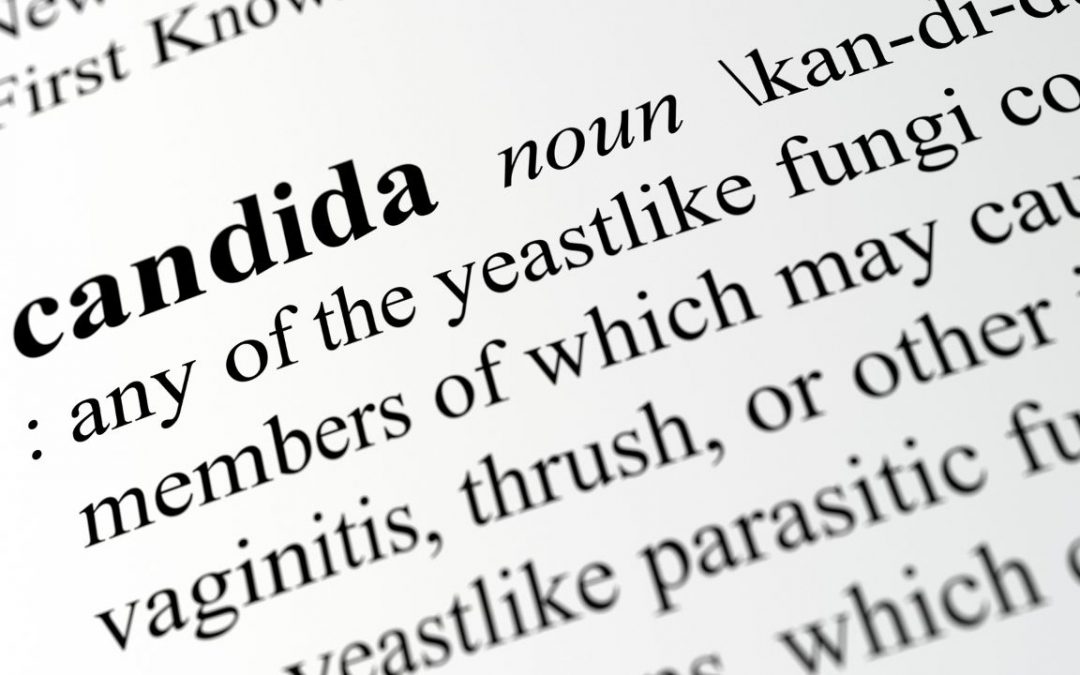What is Candida you might ask?
Candida albicans is a yeast, a type of fungus which grows within the mouth, intestines, and skin. In small amounts, this fungus is harmless to our body and leads to no symptoms.
The problems arise, however, when there is an overgrowth of Candida, which leads to infections. This is typically referred to as Candidiasis, which can be caused by a variety of factors:
- Antibiotics: Sometimes antibiotics are necessary to fight an infection or kill unwanted bacteria in the body. However, antibiotics can also kill good bacteria, such as those responsible for controlling Candida levels. This causes Candida to grow out of control and can lead to serious symptoms.
- Diet: The diet you consume has a significant impact on regulating levels of both good and bad bacteria in your gut. Sugar, refined carbohydrates, and alcohol are all substances that Candida feeds on, so overconsumption promotes Candida overgrowth.
- Immune Weakness: People who have weakened immune systems are more likely to experience Candida overgrowth. At-risk populations include the elderly, infants, and those with HIV/AIDS or other autoimmune disorders.
- Diabetes: Type 1 or Type 2 diabetes increases your chances of experiencing Candida overgrowth.
- Stress: A healthy immune system can regulate your body’s good and bad organisms. Sometimes, however, stress can lead to a shift in the balance between Candida and healthy bacteria. When we are stressed, the immune system’s ability to fight off infections is weakened.
What Are The Symptoms Of Candida Overgrowth?
How can you tell if you have Candida overgrowth in your body? Here are the tell-tale signs to look out for:
- Brain fog and Fatigue: This is one of the most common symptoms associated with Candida overgrowth and is likely due to nutritional deficiencies that accompany the condition. It also happens that having a weakened immune system leads to both fatigue and Candida, so the effects can be multiplied.
- Oral Thrush: When there is too much Candida in your mouth, white, bumpy patches will appear on the tongue, inner cheeks, or throat. This is a tell-tale visual sign of Candida, and is most common amongst the elderly, newborns, and those with weak immune systems.
- Digestive Issues: The balance of good and bad bacteria in the gut plays a large role in digestive health. As mentioned, small amounts of Candida can be present in the body and cause no problems. However, Candida overgrowth may cause various unpleasant gut-related symptoms, such as bloating, constipation, and diarrhea. Recent studies have connected Candida overgrowth with several gastrointestinal disorders such as Crohn’s and ulcerative colitis.
- Yeast Infections and Recurring UTIs: Candida naturally exists in the vaginal tract, but an overgrowth can lead to vaginal Candidiasis, also called a yeast infection. Symptoms include redness, swelling, itching, painful intercourse, and a thick, white discharge from the vagina. Vaginal yeast infections are quite common, occurring in 75% percent of women at least once. Candida overgrowth can also cause urinary tract infections (UTIs). This tends to occur amongst the elderly and immunocompromised populations. UTIs can cause burning while peeing, a more frequent need to urinate, dark and cloudy urine, and discomfort in the lower abdomen.
- Joint pain: When a Candida infection is left untreated for too long, the fungus can enter the bloodstream. This then affects the joints and can lead to arthritis. Candida can also affect the bones, causing infections or osteomyelitis. Bone and joint infections caused by Candida are uncommon but can be difficult to eliminate when they do occur.
- Hormonal imbalance: Scientists have noticed a correlation between increased estrogen levels and the overgrowth of Candida. The by-products of Candida, which can spread beyond the digestive tract, mimic estrogen, which can cause serious hormonal imbalances.
Natural Treatments for Candida Overgrowth
Treating Candida involves a thorough health assessment from your healthcare practitioner, followed by a strict elimination diet and Candida protocol as next steps.
Since food plays a crucial role in regulating healthy levels of bacteria in the gut, one of the main ways Candida overgrowth is treated is through diet. This means reducing the consumption of sugars and carbs which Candida thrives on. High-lactose dairy products can also encourage Candida to grow and should be avoided.
Along with eliminating foods that can trigger Candida, focus on foods that have been proven to fight it and promote the growth of good bacteria. Try incorporating the following into your diet:
- Garlic. Garlic has an antifungal property called allicin, which is known to fight against Candida yeast.
- Coconut oil. Due to its high lauric acid content, coconut oil can also reduce Candida.
- Pomegranate. More research needs to be done, but initial research has found that the plant compounds found in pomegranate are helpful in reducing Candida.
- Curcumin. Test tube studies show that curcumin has the ability to reduce the growth of Candida yeast and may even kill it.
- Probiotics. Probiotics promote the growth of healthy bacteria in the gut and protect against Candida. Lactobacillus is the recommended probiotic for fighting Candida overgrowth. Be sure to speak with a healthcare practitioner to guide you in the right supplements to choose for your condition.
Don’t let a Candida overgrowth run you down! It’s important to get the proper assessments and get to the root cause to create a tailored plan to cleanse your body of it for good.
Sources
Irving G, Miller D, Robinson A, Reynolds S, Copas AJ. Psychological factors associated with recurrent vaginal candidiasis: a preliminary study. Sex Transm Infect. 1998 Oct;74(5):334-8. doi: 10.1136/sti.74.5.334. PMID: 10195028; PMCID: PMC1758140.
Kumamoto CA. Inflammation and gastrointestinal Candida colonization. Curr Opin Microbiol. 2011 Aug;14(4):386-91. doi: 10.1016/j.mib.2011.07.015. Epub 2011 Jul 28. PMID: 21802979; PMCID: PMC3163673.
InformedHealth.org [Internet]. Cologne, Germany: Institute for Quality and Efficiency in Health Care (IQWiG); 2006-. Vaginal yeast infection (thrush): Overview. 2019 Jun 19. Available from: https://www.ncbi.nlm.nih.gov/books/NBK543220/
Cheng G, Yeater KM, Hoyer LL. Cellular and molecular biology of Candida albicans estrogen response. Eukaryot Cell. 2006 Jan;5(1):180-91. doi: 10.1128/EC.5.1.180-191.2006. PMID: 16400181; PMCID: PMC1360257.
Khodavandi A, Alizadeh F, Harmal NS, Sidik SM, Othman F, Sekawi Z, Jahromi MA, Ng KP, Chong PP. Comparison between efficacy of allicin and fluconazole against Candida albicans in vitro and in a systemic candidiasis mouse model. FEMS Microbiol Lett. 2011 Feb;315(2):87-93. doi: 10.1111/j.1574-6968.2010.02170.x. Epub 2011 Jan 10. PMID: 21204918.
Shino B, Peedikayil FC, Jaiprakash SR, Ahmed Bijapur G, Kottayi S, Jose D. Comparison of Antimicrobial Activity of Chlorhexidine, Coconut Oil, Probiotics, and Ketoconazole on Candida albicans Isolated in Children with Early Childhood Caries: An In Vitro Study. Scientifica (Cairo). 2016;2016:7061587. doi: 10.1155/2016/7061587. Epub 2016 Mar 14. PMID: 27051559; PMCID: PMC4808662.
Pai MB, Prashant GM, Murlikrishna KS, Shivakumar KM, Chandu GN. Antifungal efficacy of Punica granatum, Acacia nilotica, Cuminum cyminum and Foeniculum vulgare on Candida albicans: an in vitro study. Indian J Dent Res. 2010 Jul-Sep;21(3):334-6. doi: 10.4103/0970-9290.70792. PMID: 20930339
Kumar A, Dhamgaye S, Maurya IK, Singh A, Sharma M, Prasad R. Curcumin targets cell wall integrity via calcineurin-mediated signaling in Candida albicans. Antimicrob Agents Chemother. 2014;58(1):167-75. doi: 10.1128/AAC.01385-13. Epub 2013 Oct 21. PMID: 24145527; PMCID: PMC3910804.
Mailänder-Sánchez D, Wagener J, Schaller M. Potential role of probiotic bacteria in the treatment and prevention of localised candidosis. Mycoses. 2012 Jan;55(1):17-26. doi: 10.1111/j.1439-0507.2010.01967.x. Epub 2011 Jun 14. PMID: 21672043.



